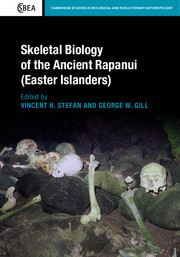Book contents
- Frontmatter
- Contents
- List of contributors
- Acknowledgements
- 1 Introduction: Research overview
- 2 Review of Polynesian and Pacific skeletal biology
- 3 Chronology and Easter Island prehistory
- 4 A descriptive skeletal biology analysis of the ancient Easter Island population
- 5 Craniometric variation of the prehistoric Polynesians and Rapanui
- 6 Rapanui non-metric cranial traits
- 7 Intra-island discrete cranial trait variation
- 8 Continuous non-metric characteristics of the early Rapanui
- 9 Rapanui dental morphology
- 10 Pelvic variability and sexual dimorphism in prehistoric Rapanui
- 11 Genetic affinities of the Rapanui
- 12 Archaeogenetics and paleodemographic estimation of founding populations: Features of residential geography on Rapa Nui
- 13 Evidence for injuries and violent death
- 14 Demographic analysis of modified crania from Rapa Nui
- 15 East Polynesian and Paleoindian parallels and contrasts in skeletal morphology
- 16 Rapanui origins, relationships, and warfare: A summary in theoretical context
- References
- Index
2 - Review of Polynesian and Pacific skeletal biology
Published online by Cambridge University Press: 05 December 2015
- Frontmatter
- Contents
- List of contributors
- Acknowledgements
- 1 Introduction: Research overview
- 2 Review of Polynesian and Pacific skeletal biology
- 3 Chronology and Easter Island prehistory
- 4 A descriptive skeletal biology analysis of the ancient Easter Island population
- 5 Craniometric variation of the prehistoric Polynesians and Rapanui
- 6 Rapanui non-metric cranial traits
- 7 Intra-island discrete cranial trait variation
- 8 Continuous non-metric characteristics of the early Rapanui
- 9 Rapanui dental morphology
- 10 Pelvic variability and sexual dimorphism in prehistoric Rapanui
- 11 Genetic affinities of the Rapanui
- 12 Archaeogenetics and paleodemographic estimation of founding populations: Features of residential geography on Rapa Nui
- 13 Evidence for injuries and violent death
- 14 Demographic analysis of modified crania from Rapa Nui
- 15 East Polynesian and Paleoindian parallels and contrasts in skeletal morphology
- 16 Rapanui origins, relationships, and warfare: A summary in theoretical context
- References
- Index
Summary
Introduction
This chapter summarizes previous work in skeletal biology of the Pacific. Although evidence from other areas in physical anthropology is included, the major focus of this survey will be what studies of human skeletons reveal about the origins, health, and lifestyle of the indigenous inhabitants of the Pacific. While interest in the origins of Pacific Islanders, particularly Polynesians, continues to command attention, more recent studies in skeletal biology and bioarchaeology focus on health, disease, and lifestyle of Pacific Islanders. Studies in dental anthropology and molecular genetics, using skeletons from Easter Island, are omitted here but will be fully discussed in other chapters in this volume.
Following a brief summary of the geography and prehistory of the Pacific, we review initial observations and descriptive reports in physical anthropology using human skeletons (primarily crania) collected during the age of scientific expeditions to the Pacific in the late eighteenth and early nineteenth centuries. Contemporaneously were more ambitious comparative analyses using crania found in museum collections; studies that unfortunately were mired in the typological paradigm of the time. Paralleling these early craniometric studies were the first anthropometric studies of the living inhabitants of the Pacific undertaken in the early decades of the twentieth century. The decades following World War II saw the first systematic archaeological excavations in the Pacific, which resulted in more extensive osteological investigations involving prehistoric human skeletons. More recently, work in the Pacific has focused on Lapita and post-Lapita skeletons (e.g., Vanuatu, New Guinea, and Fiji) and skeletons recovered during archaeological excavation and monitoring activities associated with Cultural Resource Management (CRM) work.
A plethora of early studies involved skeletons from the Pacific, but the possibilities of studying human skeletons in many parts of the Pacific are now drastically reduced due to issues surrounding repatriation and concerns of the indigenous groups. Despite these challenges, new information about the past inhabitants of the Pacific continues to emerge.
Pacific Islands: Geography, prehistory, and linguistics
Although based on a faulty perception of Pacific Island culture history (Kirch, 2000), for the sake of simplicity, this review will refer to Dumont d'Urville's (1832) tripartite division of the Pacific: Melanesia, Micronesia, and Polynesia.
- Type
- Chapter
- Information
- Publisher: Cambridge University PressPrint publication year: 2016
- 3
- Cited by



